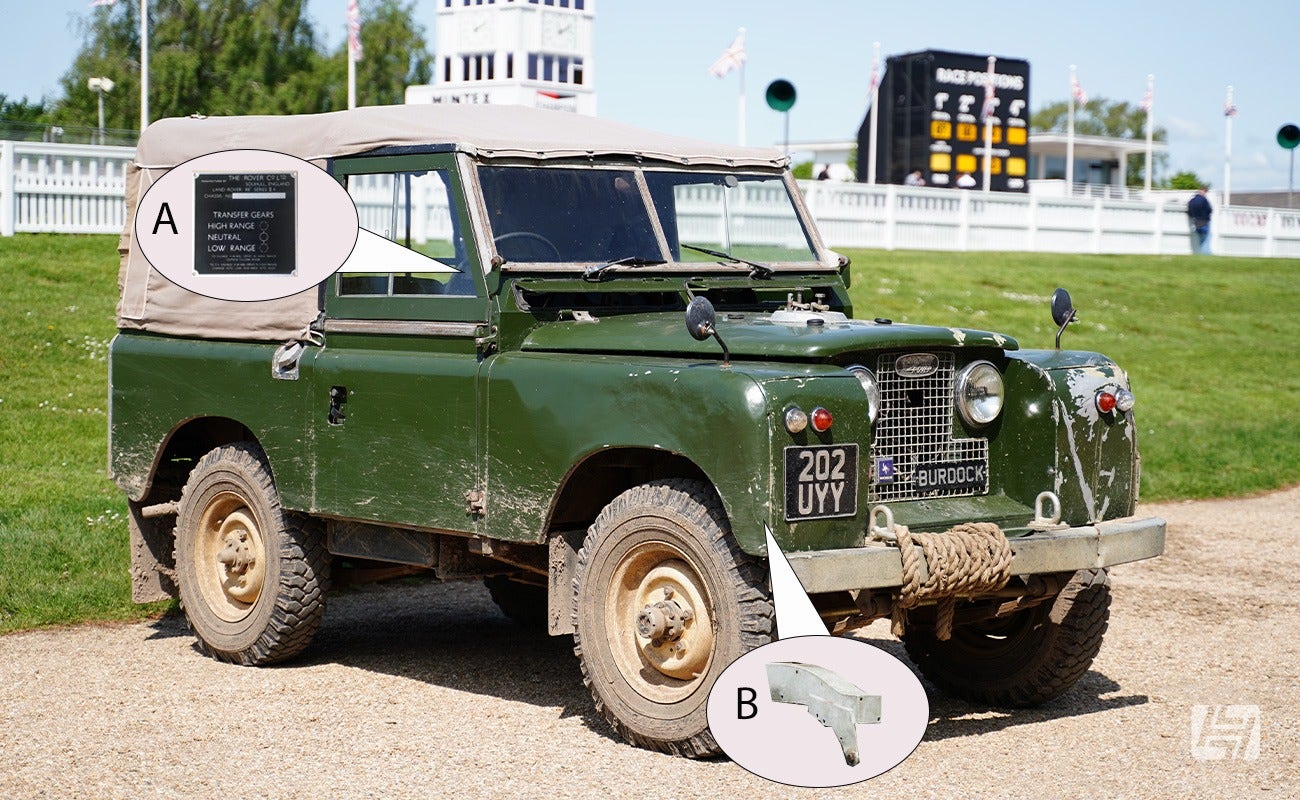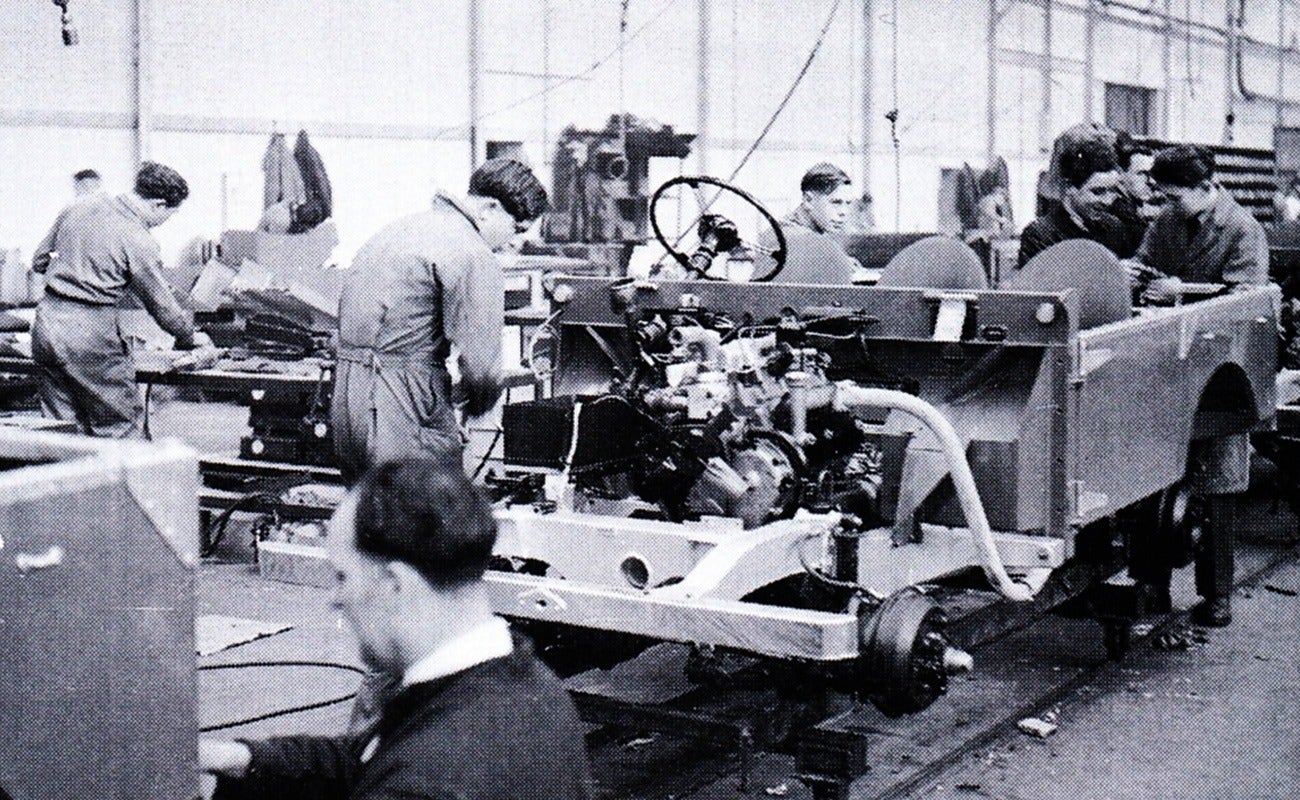Understanding Land Rover Chassis Numbers (pre-1980)
Land Rover used chassis numbers from 1948 to 1979 to help identify the origins of their vehicles. Read on and let Rob Hawkins explain what those letters and numbers mean.
If you have a Land Rover Series I-III that was manufactured before 1980, then it should have a chassis number to help identify its origins. This will consist of between six and nine digits stamped into a plate that’s riveted to the bodywork and also displayed elsewhere. From 1980 onwards, the current system of a Vehicle Identification Number (VIN) was introduced, which consists of 17 letters and numbers. We’ve explained more about these modern VINs in a separate blog, so the following information helps to explain what all those digits mean for an early chassis number.
Where is the chassis number on my Land Rover located?
The aforementioned chassis plate has the chassis number stamped into it. This plate is usually either mounted on the engine side of the bulkhead or inside the cab (position A) below the dashboard area. Because the plate is usually riveted to the bodywork, it’s very easy for it to be transferred to another vehicle, so if you are trying to confirm the identity of a vehicle, it’s worthwhile looking for another location for the chassis number. It should be stamped onto the front right-hand chassis leg (also called a dumb iron) on the outside (position B).


How many digits in a Land Rover chassis number?
For the first two years of Land Rover production (1948 and 1949), six or seven digits were used in the chassis number. From 1950 to 1955, eight digits were used for the chassis number, then nine digits until 1962 when it switched to eight digits (but a completely different system).
What year was my Land Rover built?
The first digit in the chassis number for Land Rovers produced between 1948 and 1955 indicated the year of production or manufacture. 8 stands for 1948-1949, whereas 0 is for 1950, 1 is for 1951, right up to 5 for 1955.
Realising that the numbers were running out, Land Rover moved the year of manufacture to the fourth digit between 1956 and 1961, using 6 for 1956 and coming back round to 0 and 1 for 1960 and 1961 respectively.
From 1962 until 1979, after which the new style of VIN was introduced, the chassis number didn’t include any information on the year of manufacture.


What model type is my Land Rover?
Determining whether the vehicle is a model, such as a station wagon, welder, basic or a complete knock down (CKD) for assembly is denoted by the third digit in the chassis number from 1948 to 1955, although what those numbers mean changes during that period. For the first two years (1948-1949), the number 6 stands for a basic model, 7 is for a station wagon and 8 is for a welder. This order of models was retained for 1950, but using numbers 1 to 3 and including 6 for a CKD. By 1954, this method was discontinued and the third digit identified the wheelbase, with 1 for 88in, 2 for 107in, 6 for 86in CKD and 7 for 107in CKD.
This model identification was completely redefined in 1956 whereby the second and third digits from 11 to 35 represented a Series I model, or 41 to 71 was for a Series II. And it became even more complicated from 1962 to 1979 when the first three digits denoted the model, with numbers 241 to 258 for a Series IIA 88, numbers 260 to 324 for the same model with a longer 109” wheelbase, 325 to 339 for a Series IIB (110 Forward Control), 340-354 for an IIA 109, 901 to 950 for a Series III, 951 to 955 for a Lightweight (including 895), 956 to 965 for a 101 Forward Control and finally, the numbers 355, 356 and 358 for a Range Rover.


Was your Land Rover built as LHD or RHD?
There are a few more things that peculiarly can be referenced on early model chassis numbers, but this is only applicable to Land Rover Series vehicles built up to 1956.
For example, if the chassis number starts with the letter L, it means the vehicle is left-hand drive (LHD), whereas an R means right-hand drive (RHD). This system was introduced at the start of Land Rover Series I production but was discontinued around 1951. It was replaced with the use of the fourth digit to indicate LHD and RHD, plus whether the vehicle was for the home market or export. Initially, 0 was for the home market, 3 was for LHD export and 6 was for RHD export. However, in 1954, this changed to include 0 and 1 for the home market, 3 and 4 for LHD export and 6 and 7 for RHD export. The following year saw this system refined again, using the third digit and allocating 0 for home market, 3 for LHD export, 4 for LHD CKD, 6 for RHD export and 7 for RHD CKD. After 1956, this classification was dropped.
You can also tell if your vintage off road vehicle is really a Land Rover... Despite looking the part, it can be identified as one by looking at its chassis number. Between 1948 and 1953, if the second digit is a number 6, then this signifies Land Rover. This remained in the same position for 1954-1955, but was the number 7 instead. The system was discontinued thereafter... Perhaps sticking a badge on the front was simpler?!!




How to get your Land Rover's factory build record
The information we’ve provided above will hopefully help to decipher all those digits, but we have found that there are many discrepancies, so if you really want to confirm the identity of a vehicle and know more about it, obtaining a Heritage Certificate, which is a certified copy of the vehicle's original factory record from the British Motor Industry Heritage Trust, is one solution. Prices start at £48 and they can be found here.


What if something doesn't make sense?!
The chassis number can in some cases provide a misleading history of a vehicle, especially if it has been restored and major components have been replaced. We spoke to Simon at the Land Rover Heritage Centre who told us “We tend to work on the back story to validate the provenance of our vehicles rather than rely on the VIN [chassis] number. For example, our latest acquisition - a 1958 British Rail LWB hardtop - has a very persuasive and documented back story that is not consistent with the VIN (or indeed the reg number), yet the deeper we dig the more the story is backed up. So, we will likely curate the vehicle with the story as we understand it and simply mention in passing that the VIN number seems to have been swapped along the way.”
We hope this guide goes some way to helping you understand your Land Rover chassis number. As mentioned above, if your Land Rover was made after 1980 you'll need to read our guide to Land Rover VIN numbers.
Rob Hawkins




 Beetle
Beetle
 Type 2 Bay
Type 2 Bay
 Type 2 Split
Type 2 Split
 Type 25
Type 25
 Transporter T4
Transporter T4
 Transporter T5
Transporter T5
 Golf Mk1
Golf Mk1
 Golf Mk2
Golf Mk2


 911
911
 996
996
 997
997
 986 Boxster
986 Boxster
 987 Boxster
987 Boxster
 912
912
 944
944
 924
924


 Defender
Defender
 Discovery Series 1
Discovery Series 1
 Discovery 2
Discovery 2
 Series 1, 2 & 3
Series 1, 2 & 3
 Freelander
Freelander
 Freelander 2
Freelander 2





